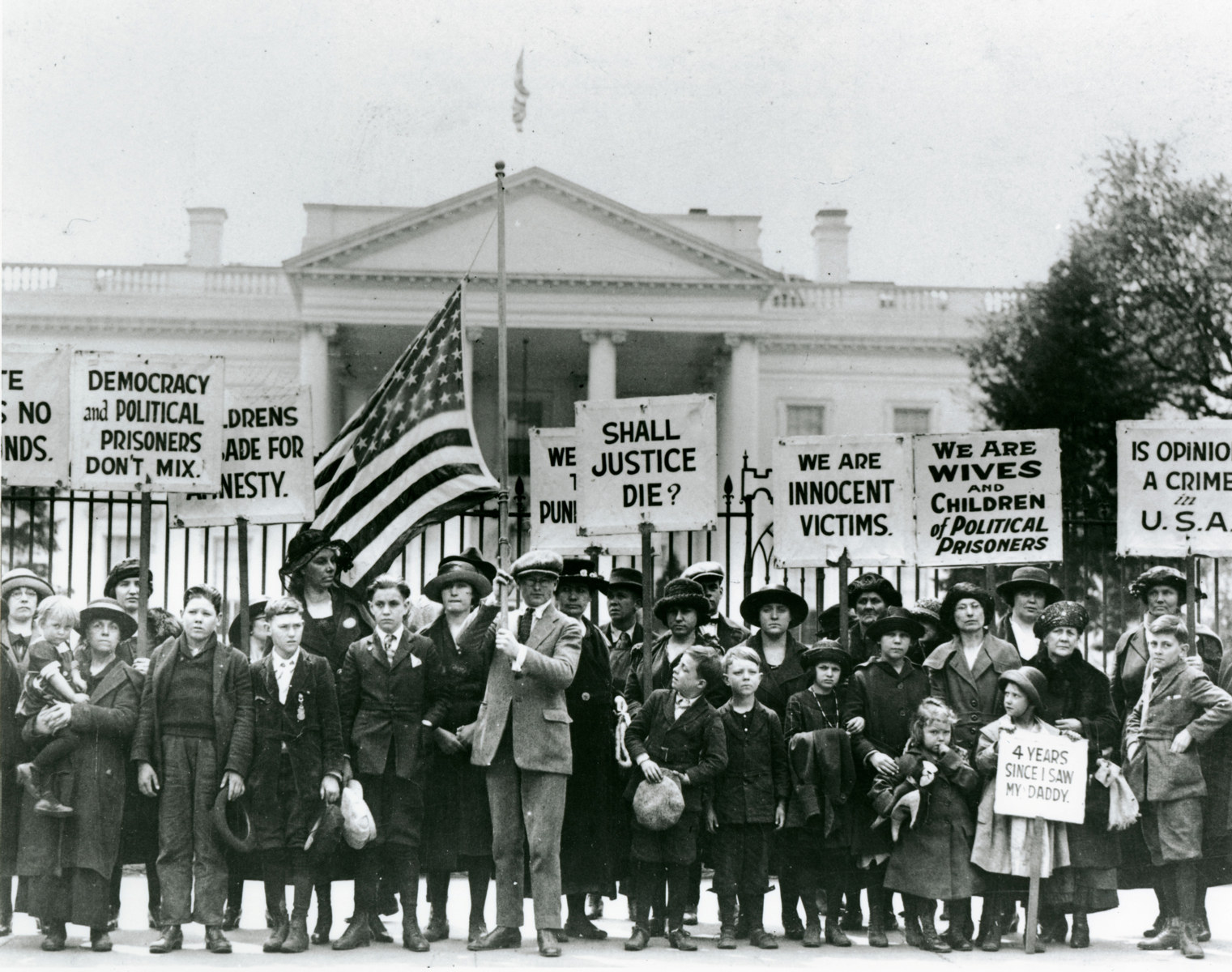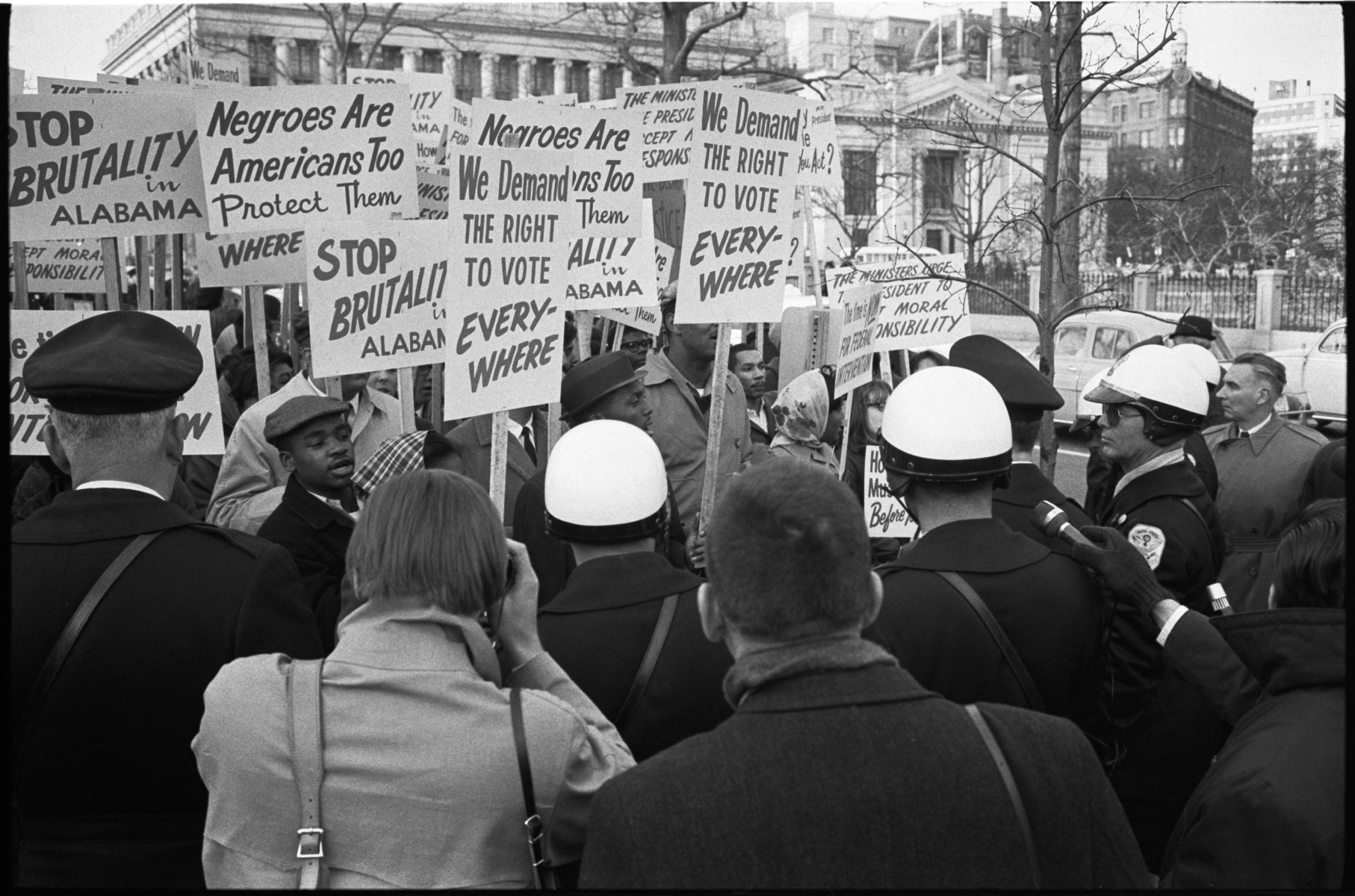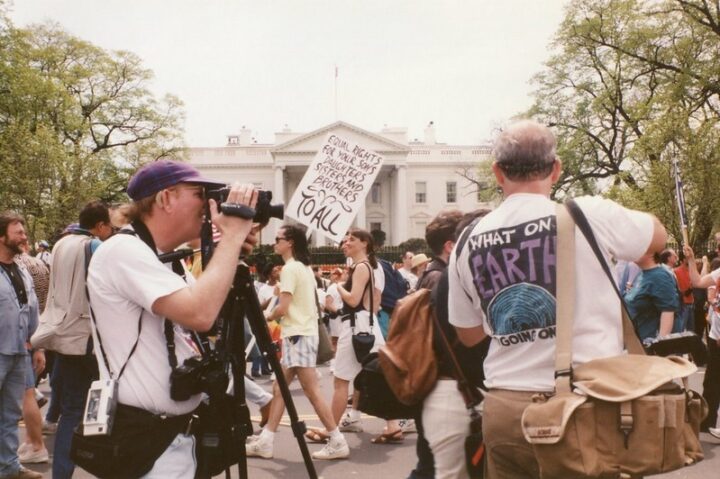Collection Native Americans and the White House
Native Americans hold a significant place in White House history. For thousands of years, Indigenous peoples, including the Nacotchtank and...

Main Content

This photograph of Lafayette Park was taken by Bruce White for the White House Historical Association on January 13, 2016. Lafayette Park has historically been a site for protest and activism in the United States.
White House Historical Association
The first suffrage picket line leaves the National Woman's Party headquarters to march to the White House gates on January 10, 1917.
Library of Congress
Suffragette Alison Trumbull Hopkins holds a banner which reads "Mr. President How Long Must Women Wait for Liberty" at the North Gates of the White House, ca. 1917.
Library of Congress
Families campaign for the release of political prisoners in front of the North Gates at the White House on April 19, 1922, during the Warren G. Harding administration. The group was called the "Children's Crusade" and called for the release of those convicted under the Espionage Act of 1917.
Library of Congress
Five hosiery workers protest against the American boycott of Japanese silk on January 28, 1938. Three hundred women from the American Federation of Hosiery Workers marched from Union Station to the White House to protest the boycott, which the United States implemented in response to Japan's invasion of China in 1937. In this photograph, a woman holds a sign which asks "Were your lisle stockings made in Nazi Germany?"
Library of Congress
President John F. Kennedy and Vice President Lyndon B. Johnson meet with members of the civil rights movement and leaders of the March on Washington in the Oval Office. Left to right: Secretary of Labor Willard Wirtz; Martin Luther King, Jr.; Eugene Carson Blake of the National Council of Churches; President Kennedy; Vice President Johnson; and Walter Reuther of the United Auto Workers. Others (not in order): A. Philip Randolph of the AFL-CIO; John Lewis, Chairman of the Student Nonviolent Coordinating Committee (SNCC) and future congressman for Georgia's 5th District; Whitney M. Young of the National Urban League; Mathew H. Ahmann of the National Catholic Conference for Interracial Justice; Rabbi Joachim Prinz of the American Jewish Congress; Roy Wilkins of the NAACP; and Floyd B. McKissick of the Congress of Racial Equality.
John F. Kennedy Presidential Library and Museum/NARA
African American demonstrators hold a protest near the White House on March 12, 1965. The protesters carried signs condemning police brutality and demanding the right to vote. The protest was held in response to violence by police against civil rights protesters in Selma, Alabama.
Library of Congress
Protest sign from the first documented and organized gay rights picket at the White House on April 17, 1965. The consistent deterioration of rights for LGBTQ+ citizens during the “Lavender Scare” led to the homophile movement and organized protest. Frank Kameny, who had been fired from his job as a federal astronomer for being gay, led the demonstration alongside members of the Washington, D.C. chapter of the Mattachine Society, one of the oldest LGBTQ+ activist organizations in the country. Prominent lesbian activists Barbara Gittings and Ernestine Eckstein also picketed that day. Participants wore business attire to present themselves as respectable professionals and to draw attention to the issue at hand—discrimination in the workplace.
Collection of Frank Kameny, Smithsonian National Museum of American History
Vietnam War protestors hand out flyers and line the North Gates of the White House in June 1966. They stand in front of a banner that reads: "We Mourn Our Soldiers: They are Dying in Vain." While U.S. involvement in Vietnam dated back to the Eisenhower administration, the escalation of the war during the 1960s and 1970s dominated national politics, tarnished the United States’ reputation abroad, and cost 58,000 Americans and over 3 million Vietnamese their lives.
White House Historical Association
Demonstrators stage a protest of the Vietnam War in front of the northern fence of the White House on January 19, 1968. The protesters carried signs including statements such as "No more...Stop the war!" "Eartha Kitt speaks for the women of America", and "Stop the draft." The previous day, singer and actress Eartha Kitt had become the subject of much controversy for her statements against the war during a luncheon at the White House hosted by Lady Bird Johnson.
Library of Congress
Coretta Scott King holds a candle to lead a vigil in front of the White House as part of the Moratorium to End the War in Vietnam on the night of October 15, 1969. Over 250,000 people took part in the march in Washington, D.C. to protest American involvement in the Vietnam War.
Library of Congress
Thousands of demonstrators march along Pennsylvania Avenue, in front of the White House, to protest President Richard Nixon's expansion of the Vietnam War with a military campaign into Laos on February 10, 1971.
Library of Congress
Conservative activist Phyllis Schlafly and other demonstrators, part of "Stop ERA," protest the Equal Rights Amendment outside of the White House on February 4, 1977. Originally introduced in Congress in 1923, the Equal Rights Amendment sought to ensure equal legal treatment for citizens regardless of sex.
Library of Congress
The National March on Washington for Lesbian, Gay, and Bi Equal Rights and Liberation passes the White House in 1993. The march remains one of the largest protests in American history, with approximately one million attendees; other large marches include the Millennium March (2000), the National Equality March (2009), and the National Pride March (2017).
Elvert Barnes PhotographyAbout this Gallery
For more than a century, thousands of Americans have gathered in Lafayette Park across from the White House to exercise their First Amendment rights and bring awareness to their respective causes. In this collection, explore how individuals, groups, and organizations historically used this space to advocate equality, protest policy, and demand action from the neighborhood's most powerful occupant.
Native Americans hold a significant place in White House history. For thousands of years, Indigenous peoples, including the Nacotchtank and...
While there has yet to be a female president, women have played an integral role in shaping the White House...
The White House Historical Association and the Eleanor Roosevelt Papers Project present this collaboration in an effort to open a...
For more than two centuries, the White House has been the home of American presidents. A powerful symbol of the...
For more than a century, thousands of Americans have gathered in Lafayette Park across from the White House to exercise...
First Lady Lou Hoover's invitation to Jessie L. DePriest to a White House tea party in 1929 created a storm of...
As part of the White House Historical Association’s 60th anniversary celebration in 2021, the Next-Gen Leaders (NGL) initiative was announced. Th...
A master of the art of practical politics, Lyndon Johnson came into the White House after the tragedy of President...
Before the U.S. Chamber of Commerce Building was built during 1922-25, a simple three-and-a-half story brick home stood in...
Five hundred and forty-seven dollars and fifty cents. According to the records of the District of Columbia that is the...
Every president since James Madison has attended services at St. John's Church. This distinctive yellow church was the second building...
The Rodgers HouseThe Rodgers House, formerly at 717 Madison Place, was constructed in 1831 by Commodore John Rodgers, a high-ranking naval officer....